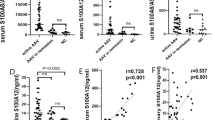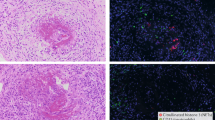Abstract
Objectives
Anti-neutrophil cytoplasmic antibodies (ANCA)-associated vasculitides (AAV) are a group of systemic autoimmune disorders characterized by necrotizing inflammation of small- to medium-sized blood vessels. The pathogenesis of patients with AAV are still in investigation. In this study, we explored the involvement of LL-37 and nucleic acids in AAV.
Methods
15 patients with AAV diagnosed according to the Chapel Hill definition between October 2014 and July 2015 in the department of Nephrology of Huangdao, affiliated Hospital of Qingdao University were enrolled. 16 patients with chronic bronchitis (CB) were selected as disease control group. 15 cases of healthy people from Medical Healthy Center were as healthy control group. Peripheral blood mononuclear cells (PBMCs) were collected from these groups and stimulated by LL-37and (or) two types of CpG-ODN for 7 days. The IFN-α and ANCA in vitro were measured by ELISA. The serum IFN-α, LL-37 and ANCA were measured also.
Results
The serum level of IFN-α in AAV group was much higher than that in CB group (692.13 ± 407.28 vs 397.07 ± 211.62 pg/ml, p = 0.019), and that in healthy control group (692.13 ± 407.28 vs 251.54 ± 190.46 pg/ml, p < 0.001). The serum level of LL-37 in AAV group was much higher than that in CB group (101.18 ± 66.59 vs 40.23 ± 13.51 ng/ml, p < 0.001, and that in healthy control group (101.18 ± 66.59 vs 27.80 ± 16.86 ng/ml, p < 0.001). Also the level of IFN-α showed a significant positive relationship with ANCA in AAV group both in serum and in supernatant of cultured PBMCs stimulated by LL-37 and (or) CpG-ODN (r = 0.783, p = 0.001; r = 0.575, p = 0.064; r = 0.649, p = 0.031; r = 0.806, p = 0.003). In patients with AAV, the supernatant levels of IFN-α in cultured PBMCs stimulated by LL-37 and (or) CpG-ODN were higher than that without stimulating factor (p < 0.05). The supernatant level of IFN-α in cultured PBMC stimulated by LL-37 alone was lower than that stimulated by CpGA alone (699.57 ± 476.26 vs 2342.63 ± 2025.11 pg/ml, p = 0.001). But the supernatant level of IFN-α in cultured PBMCs stimulated by LL-37 alone was higher than in that stimulated by CpGB alone (699.57 ± 476.26 vs 153.35 ± 78.08 pg/ml, p < 0.001). The supernatant level of IFN-α in cultured PBMCs stimulated by both LL-37 and CpG-ODN was higher than that stimulated by LL-37 or CpG-ODN alone (2550.57 ± 2217.41 vs 699.57 ± 476.26 pg/ml, p = 0.003; 2550.57 ± 2217.41 vs 153.35 ± 78.08 pg/ml, p = 0.001; 2660.95 ± 391.31 vs 699.57 ± 476.26 pg/ml, p < 0.001; 2660.95 ± 391.31 vs 153.35 ± 78.08 pg/ml, p < 0.001). Either it is stimulated by LL-37 or CpG-ODN or both, the supernatant level of IFN-α in cultured PBMCs in AAV patients was the highest, that in healthy controls was the lowest. Either stimulated by LL-37 or CPG-ODN, or both, the levels of ANCA production in vitro in AAV groups were statistically significantly higher than those in CB group and healthy control group.
Conclusions
There were higher serum levels of LL-37 and IFN-α in patients with AAV. IFN-α could reach a higher level stimulated by LL-37 and nucleic acids both of which are related to infection. Patients with AAV have ANCA-producing B lymphocytes in the circulation even in remission stage. Infections could induce the relapse of AAV.








Similar content being viewed by others
References
Kallenberg CG, Heeringa P, Stegeman CA (2006) Mechanisms of disease: pathogenesis and treatment of ANCA-associated vasculitides. Nat Clin Pract Rheumatol 2:661–670
Jennette JC, Falk RJ (1997) Small-vessel vasculitis. N Engl J Med 337:1512–1523
Zycinska K, Wardyn KA, Zielonka TM, Demkow U, Traburzynski MS (2008) Chronic crusting, nasal carriage of Staphylococcus aureus and relapse rate in pulmonary Wegener’s granulomatosis. J Physiol Pharmacol 59(Suppl. 6):825–831
Stegeman CA, Tervaert JW, Kallenberg CG (1997) Co-trimoxazole and Wegener’s granulomatosis: more than a coincidence. Nephrol Dial Transpl 12:652–655
Frasca L, Lande R (2012) Role of defensins and cathelicidin LL37 in autoimmune and auto-inflammatory diseases. Curr Pharm Biotechnol 13:1882–1897
Kessenbrock K, Krumbholz M, Schonermarck U, Back W, Gross WL, Werb Z, Grone HJ, Brinkmann V, Jenne DE (2009) Netting neutrophils in autoimmune small-vessel vasculitis. Nat Med 15:623–625
Hurtado PR, Jeffs L, Nitschke J et al (2008) CpG oligodeoxynucleotide stimulates production of anti-neutrophil cytoplasmic antibodies in ANCA associated vasculitis. BMC Immunol 9:34
Tadema Henko, Abdulahad Wayel H, Lepse Nikola et al (2011) Bacterial DNA motifs trigger ANCA production in ANCA-associated vasculitis in remission. Rheumatology 50:689–696
Stegeman CA, Tervaert JW, Kallenberg CG (1997) Co-trimoxazole and Wegener’s granulomatosis: more than a coincidence. Nephrol Dial Transpl 12:652–655
Kobayashi O (1998) Clinical role of autoantibody against bactericidal/permeability-increasing protein in chronic airway infection. J Infect Chemother 4(2):83–93
Ohtami S, Kobayashi O, Ohtami H (2001) Analysis of intractable factors in chronic airway infections: role of the autoimmunity induced by BPI-ANCA. J Infect Chemother 7(4):228–238
Kallenberg CG (2011) Pathogenesis of ANCA-associated vasculitis, an update. Clin Rev Allergy Immunol 41(2):224–231
Kobayashi O, Ohtami H, Hellmich B (2001) Anti-MPO-ANCA-positive microscopic polyangiitis following subacute bacterial endocarditis. J Infect Chemother 7:228–238
Flores-Suarez LF, Cabiedes J, Villa AR, van der Woude FJ, Alcocer-Varela J (2003) Prevalence of antineutrophil cytoplasmic autoantibodies in patients with tuberculosis. Rheumatology (Oxford) 42:223–229
Lamprecht P, Gutzeit O, Csernok E, Gause A, Longombardo G, Zignego AL, Gross WL, Ferri C (2003) Prevalence of ANCA in mixed cryoglobulinemia and chronic hepatitis C virus infection. Clin Exp Rheumatol 21:S89–S94
Hermann J, Demel U, Stunzner D, Daghofer E, Tilz G, Graninger W (2005) Clinical interpretation of antineutrophil cytoplasmic antibodies: parvovirus B19 infection as a pitfall. Ann Rheum Dis 64:641–643
van der Does AM, Beekhuizen H, Ravensbergen B, Vos T, Ottenhoff THM, van Dissel JT, Drijfhout JW, Hiemstra PS, Nibbering PH (2010) LL-37 directs macrophage differentiation toward macrophages with a proinflammatory signature. J. Immunol 185:1442–1449
Knight JS, Kaplan MJ (2012) Lupus neutrophils: ‘NET’ gain in understanding lupus pathogenesis. Curr Opin Rheumatol 24:441–450
Zhang Ying, Shi Weiwei, Tang Sha, Li Jingyi et al (2013) The influence of cathelicidin LL37 in human anti-neutrophils cytoplasmic antibody (ANCA)-associated vasculitis. Arthritis Res Ther 15:R161
Chamilos G, Gregorio J, Meller S, Lande R, Kontoyiannis DP, Modlin RL, Gilliet M (2012) Cytosolic sensing of extracellular self-DNA transported into monocytes by the antimicrobial peptide LL37. Blood 120:3699–3707
Garcia-Romo GS, Caielli S, Vega B, Connolly J, Allantaz F, Xu Z, Punaro M, Baisch J, Guiducci C, Coffman RL, Barrat FJ, Banchereau J, Pascual V (2011) Netting neutrophils are major inducers of type I IFN production in pediatric systemic lupus erythematosus. Sci Transl Med 3:73ra20
Nakazawa D, Tomaru U, Suzuki A et al (2012) Abnormal conformation and impaired degradation of propylthiouracil-induced neutrophil extracellular traps: implications of disordered neutrophil extracellular traps in a rat model of myeloperoxidase antineutrophil cytoplasmic antibody-associated vasculitis. Arthritis Rheum 64(11):3779–3787
Nakazawa Daigo, Shida Haruki, Tomaru Utano et al (2014) Enhanced formation and disordered regulation of NETs in myeloperoxidase-ANCA-associated microscopic polyangiitis. J Am Soc Nephrol 25:9
Wang ZL, Xing GQ, Shang JC et al (2014) The significance of serum peptidylarginine deiminase type 4 in ANCA-associated vasculitis. J Peking Univ (Health Sci) 46(1):51–57
Muller A, Trabandt A, Gloeckner-Hofmann K et al (2000) Localized Wegener’s granulomatosis: predominance of CD26 and IFN-gamma expression. J Pathol 192:113–120
Voswinkel J, Mueller A, Kraemer JA et al (2006) B lymphocyte maturation in Wegener’s granulomatosis: a comparative analysis of VH genes from endonasal lesions. Ann Rheum Dis 65:859–864
Stone JH, Merkel PA, Spiera R et al (2010) Rituximab versus cyclophosphamide for ANCA-associated vasculitis. N Engl J Med 363:221–232
Jones RB, Tervaert JW, Hauser T et al (2010) Rituximab versus cyclophosphamide in ANCA-associated renal vasculitis. N Engl J Med 363:211–20, 90–997
Acknowledgments
This study was supported by Grants from the Health and Familily Planning Commission of Shandong (2014WS0176) and People’s Livelihood Science and Technology Program of Qingdao(15-9-2-90-nsh).
Author information
Authors and Affiliations
Corresponding author
Ethics declarations
Conflict of interest
There is no conflict of interest.
Ethical approval
Ethical approval for this investigation was obtained from the Research Ethics Committee, affiliated Hospital of Qingdao University.
Informed consent
Informed consent was obtained from all participants.
Rights and permissions
About this article
Cite this article
Luan, Jj., Xing, Gq. Pathogenesis of antimicrobial peptides LL-37 and CpG-ODN in ANCA associated vasculitis. J Nephrol 30, 63–71 (2017). https://doi.org/10.1007/s40620-016-0336-z
Received:
Accepted:
Published:
Issue Date:
DOI: https://doi.org/10.1007/s40620-016-0336-z




